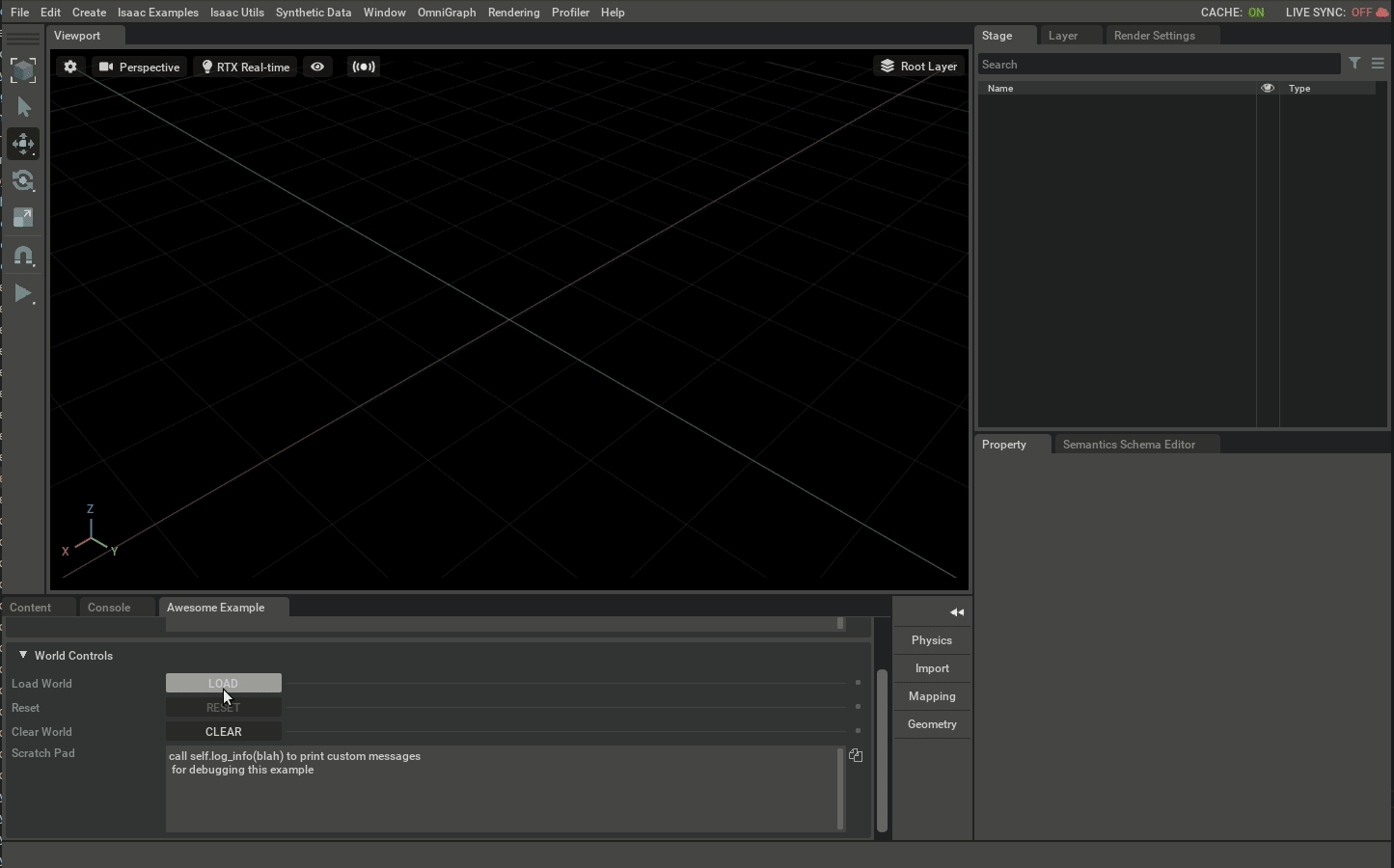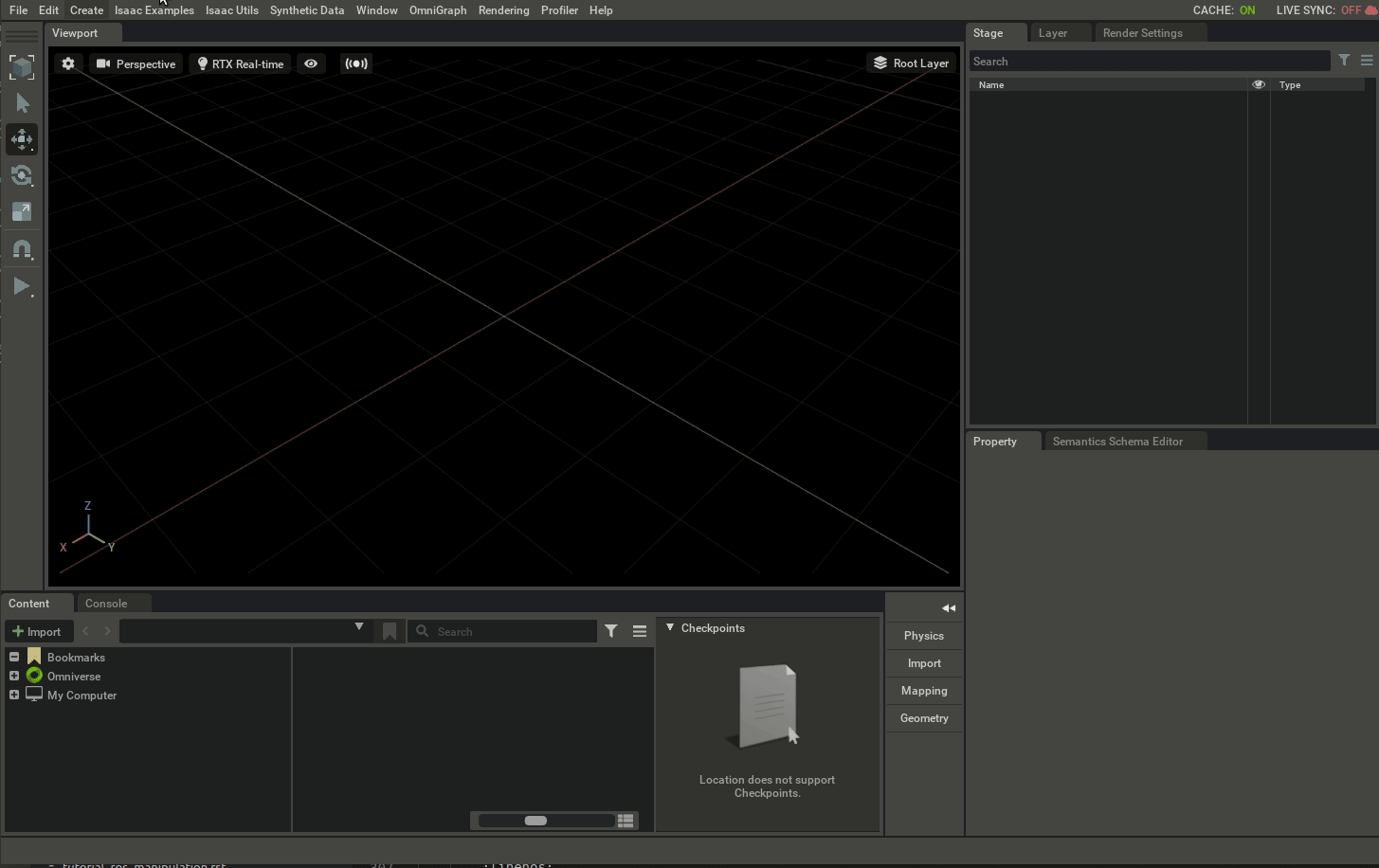3. Hello World¶
3.1. Learning Objectives¶
Tutorials 3–8 in the Required Tutorials series build on each other to create a complex simulation with multiple robots executing multiple tasks as shown below.
This tutorial sets the foundation of the simulation. It introduces the programming API using the main workflows to create your robotics application using Omniverse Isaac Sim. After this tutorial, you will understand how to add a rigid body to the Stage and simulate it using python in Omniverse Isaac Sim.
10-15 Minute Tutorial
3.2. Getting Started¶
Prerequisites
Intermediate knowledge in python and asynchronous programming is required for this tutorial.
Please download and install Visual Studio Code prior to beginning this tutorial.
Please review Isaac Sim Interface prior to beginning this tutorial.
Please review Isaac Sim Workflows prior to beginning this tutorial.
Let’s begin by opening the Hello World example. Go to the top Menu Bar and Click Isaac Examples > Hello World.
The window for the Hello World example extension should now be visible in the workspace. Click the Open Source Code button to launch the source code for editing in Visual Studio Code.
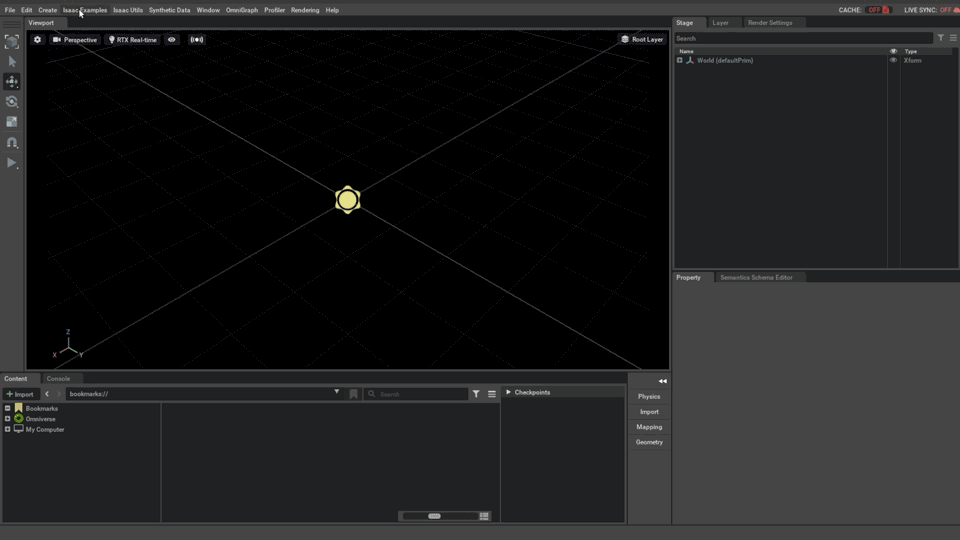
Click the Open Containing Folder button to open the directory containing the example’s files. This folder contains three files hello_world.py, hello_world_extension.py and __init__.py.
hello_world.py is where the logic of the application will be added while the UI elements of the application will be added in hello_world_extension.py and thus linked to the logic.
Click on the LOAD button to load the World.
Click on the CLEAR button to clear the World.
Click on the LOAD button to load the World again.
Open
hello_world.pyand pressCtrl+Sto checkout the hot-reload feature. You will notice that the menu disappeared from the workspace (because it was restarted).Open now the example menu again and click on the LOAD button.
Now we can begin adding to this example.
3.3. Code Overview¶
This example inherits from BaseSample which is a boilerplate extension application which sets up the basics for every robotics extension application, such as:
Loading the world with its corresponding assets using a button
Clearing the world using a button
Resetting the world’s objects to their default states.
Handling hot reloading and much more…
World is the core class that enables you to interact with the simulator in an easy and modular way. It takes care of many time-related events such as adding callbacks, stepping physics, resetting the scene, adding tasks (this will be covered later in Adding a Manipulator Robot), etc.
A world contains an instance of a Scene. The Scene class manages simulation assets of interest in the USD Stage. It provides an easy API to add, manipulate, inspect, and reset different USD assets in the stage.
1 2 3 4 5 6 7 8 9 10 11 12 13 14 15 | from omni.isaac.examples.base_sample import BaseSample #boiler plate of a robotics extension application
class HelloWorld(BaseSample):
def __init__(self) -> None:
super().__init__()
return
# This function is called to setup the assets in the scene for the first time
# Class variables should not be assigned here, since this function is not called
# after a hot-reload, its only called to load the world starting from an EMPTY stage
def setup_scene(self):
# A world is defined in the BaseSample, can be accessed everywhere EXCEPT __init__
world = self.get_world()
world.scene.add_default_ground_plane() # adds a default ground plane to the scene
return
|
3.3.1. Singleton World¶
World is a Singleton which means only one World can exist while running Omniverse Isaac Sim. The code below demonstrates how to retrieve the current instance of the World across different files and extensions.
1 2 3 4 5 6 7 8 9 10 11 12 | from omni.isaac.examples.base_sample import BaseSample
from omni.isaac.core import World
class HelloWorld(BaseSample):
def __init__(self) -> None:
super().__init__()
return
def setup_scene(self):
world = World.instance()
world.scene.add_default_ground_plane()
return
|
3.4. Adding to the Scene¶
Let’s use the python API to add a cube as a rigid body to the scene.
Press
Ctrl+Sto save the code and hot-reload Omniverse Isaac Sim.Open the menu again
If we change anything in
setup_scene,CLEARthenLOADbuttons need to be pressed. Otherwise, only theLOADbutton need to be pressed. In this case, we need to pressCLEARthenLOAD.Press the
PLAYbutton to start simulating the dynamic cube and see it falling.
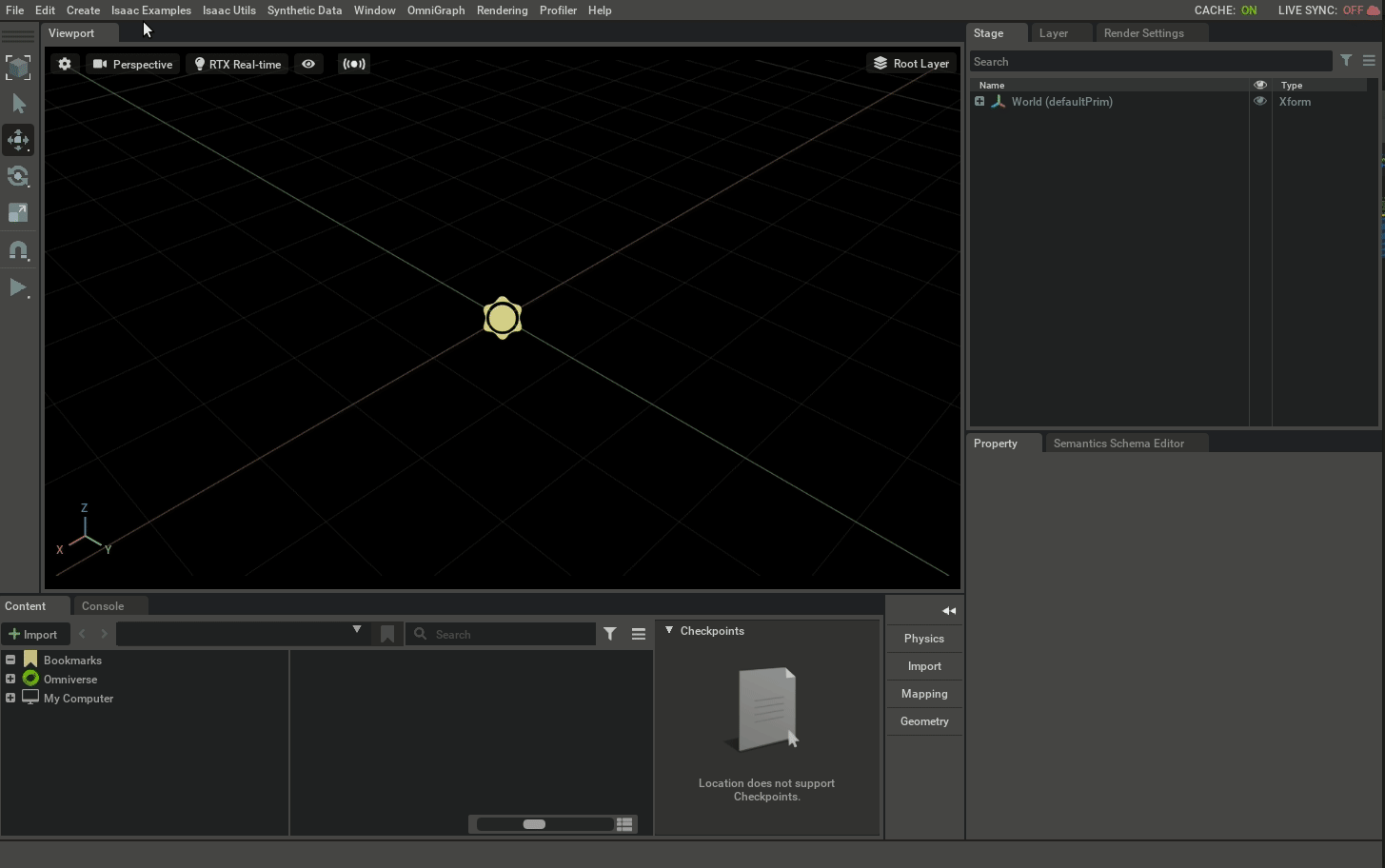
Note
Every time the code is edited/changed, Press Ctrl+S to save the code and hot-reload Omniverse Isaac Sim.
3.5. Inspecting Objects Properties¶
Let’s print the cube’s world pose and velocity.
3.5.1. Continuously Inspecting the Object Properties during Simulation¶
Let’s print the cube’s world pose and velocity during simulation at every physics step executed. As mentioned in Isaac Sim Workflows, in this workflow the application is running asynchronously and can’t control when to step physics. However, callbacks can be added to ensure certain things happen before certain events.
Let’s learn how to add a physics callback here.
3.7. Converting it to a Standalone Application¶
As mentioned in Isaac Sim Workflows, in this workflow, the robotics application is started when launched from python right away and we have control over when to step physics and rendering.
Open a new file my_application.py and add the following.
1 2 3 4 5 6 7 8 9 10 11 12 13 14 15 16 17 18 19 20 21 22 23 24 25 26 27 28 29 30 31 32 33 34
#launch Isaac Sim before any other imports #default first two lines in any standalone application from omni.isaac.kit import SimulationApp simulation_app = SimulationApp({"headless": False}) # we can also run as headless. from omni.isaac.core import World from omni.isaac.core.objects import DynamicCuboid import numpy as np world = World(stage_units_in_meters=0.01) world.scene.add_default_ground_plane() fancy_cube = world.scene.add( DynamicCuboid( prim_path="/World/random_cube", name="fancy_cube", position=np.array([0, 0, 100.0]), size=np.array([50.15, 50.15, 50.15]), color=np.array([0, 0, 1.0]), )) # Resetting the world needs to be called before querying anything related to an articulation specifically. # Its recommended to always do a reset after adding your assets, for physics handles to be propagated properly world.reset() for i in range(500): position, orientation = fancy_cube.get_world_pose() linear_velocity = fancy_cube.get_linear_velocity() # will be shown on terminal print("Cube position is : " + str(position)) print("Cube's orientation is : " + str(orientation)) print("Cube's linear velocity is : " + str(linear_velocity)) # we have control over stepping physics and rendering in this workflow # things run in sync world.step(render=True) # execute one physics step and one rendering step simulation_app.close() # close Isaac Sim
Run it using python my_application.py. Note: if you didn’t setup your python environment, you can use python.sh located at ~/.local/share/ov/pkg/isaac_sim-2021.2.1/
3.8. Converting it to a Standalone Application using Jupyter Notebook¶
Open a jupyter notebook
cd ~/.local/share/ov/pkg/isaac_sim-2021.2.1/ ./jupyter_notebook.sh standalone_examples/notebooks/hello_world.ipynb
Access the notebook through the browser as shown on the terminal
Execute the first cell in the notebook
1 2 3 4 5 6
import getpass user = getpass.getuser() from omni.isaac.kit import SimulationApp # Set the path below to your desired nucleus server # Make sure you installed a local nucleus server before this simulation_app = SimulationApp({"livesync_usd": f'omniverse://localhost/Users/{user}/temp_jupyter_stage.usd'})
Open the same usd file after launching Isaac Sim through the launcher or the terminal and turn the live syncing option on. Note: DON’T press play, pause or stop in the GUI in this workflow.
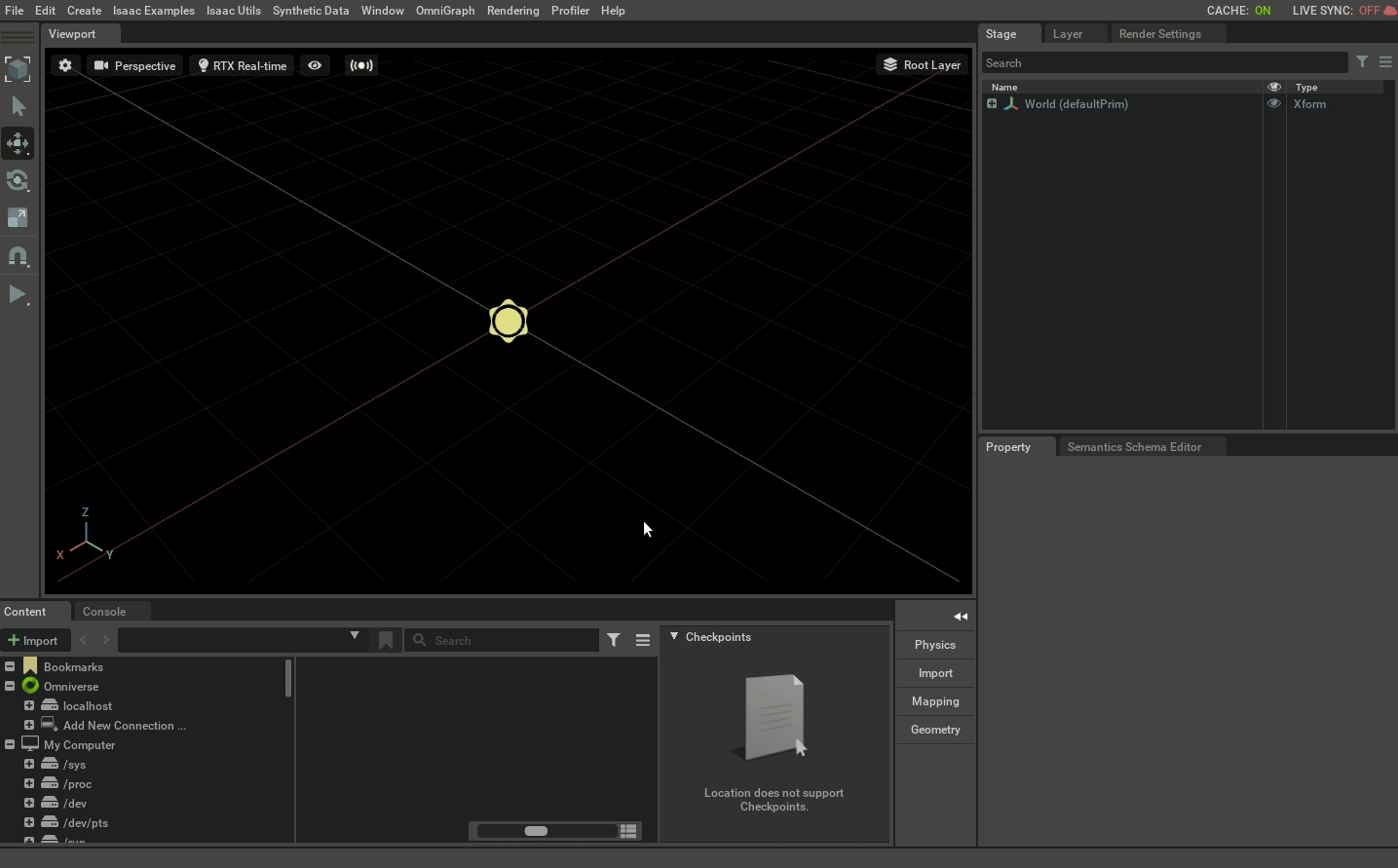
Run through the rest of the cells in the notebook, while viewing the stage directly in Omniverse Isaac Sim GUI.
Note
DON’T press play, pause or stop in the GUI in this workflow.
Note
A .render call is needed at the end of each cell in order for the changes to propagate to the synced USD (i.e World.render or SimulationContext.render)
Note
Use world.clear() or clear_stage at the beginning of a cell for iterative development.
3.9. Summary¶
This tutorial covered the following topics:
Overview of what is
WorldandSceneclasses.Adding Content to the Scene via Python
Adding Callbacks
Accessing Dynamic Properties for Objects
Main differences in a standalone application
Main differences when developing your application using jupyter
3.9.1. Next Steps¶
Continue on to the next tutorial in our Essential Tutorials series, Hello Robot, to learn how to add a robot to the simulation.
Note: next tutorials will be developed mainly using the extensions application workflow. However, conversion to other workflows should be straightforward given what was covered in this tutorial.
